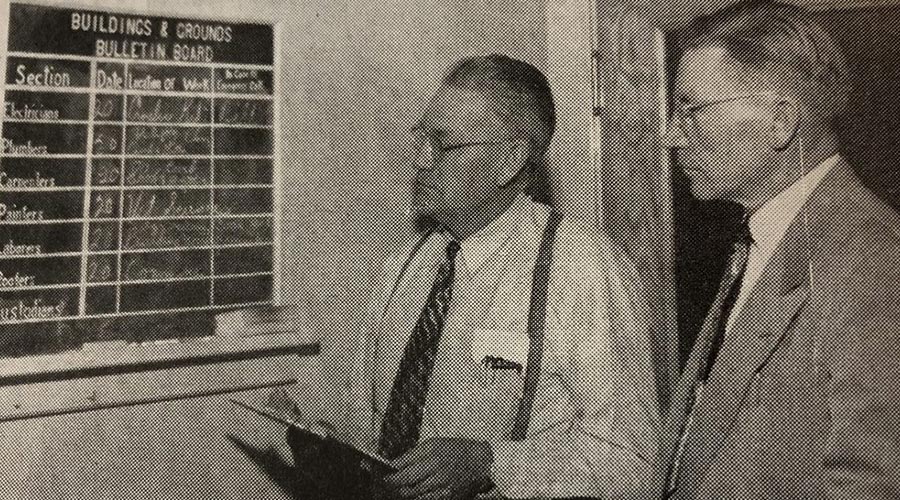Change Agent
Stephen Bell rose to the top because he's not afraid to shake things up. In fact, he enjoys it
By Edward Sullivan, Editor
Stephen Bell had a great job. As president of Fidelity Real Estate, he was doing work he loved in a company that understood the business value of the built environment. So when he was offered another position within the Fidelity family of companies in 2004, he had to think about it carefully. As he weighed the choice, Bell did something that few facility executives would have a chance to do: He sought out the opinion of the chairman of his company, Edward C. Johnson.
“I asked him what he would prefer, and he said, ‘I’d prefer you take the new job,’” Bell says.
Bell’s access to the highest levels of leadership in the financial services giant is a measure both of the importance Fidelity places on real estate and Bell’s own accomplishments. But Johnson’s answer was far from the only reason Bell took the new job as president of Pembroke Real Estate, Fidelity’s $1.6 billion private real estate development arm. For Bell, it was the opportunity to tackle a new challenge that ultimately led him to move from Boston, where Fidelity is headquartered and where Bell had spent much of his career even before joining Fidelity, to London, where Pembroke is headquartered.
With three decades of experience, Bell knew corporate real estate inside and out, from design and construction to real estate planning and asset management. Becoming president of Pembroke required Bell to immerse himself in a very different arena: the intricacies of real estate investments. But that challenge was part of the appeal of the new slot. Bell’s willingness to embrace change — and more than embrace, to drive change — has been at the heart of his career.
Pembroke invests in and manages real estate globally, not for Fidelity’s mutual funds, but for the firm itself; the money comes from Fidelity’s retained earnings. Its portfolio includes 3.2 million square feet of space in the United States, the United Kingdom and Japan. The company’s primary focus is class A office space, but Pembroke will also invest in residential, mixed-use and retail properties. The firm is in the process of acquiring three more properties, including one in Brussels, and is constantly looking for new opportunities.
The company is global in the truest sense of the word. On a recent day, a Pembroke staff member from the London office was in India working on a deal for a property in Bangalore, while Bell spent the morning on the phone with someone from the Paris office talking about an investment there. The company had just purchased a large property in Washington, D.C., and was looking at possible real estate transactions there as well.
It’s a far cry from corporate real estate. But just entering the world of corporate real estate represented a change of plans for Bell.
Taking Charge
Bell began his career as an architect, a profession he had aimed for since high school. But after he had practiced and taught architecture, a light bulb went on in his head.
“What I realized was that the people who had the money were the ones making all the decisions,” Bell says. “I had an epiphany. I loved real estate, I loved design, I loved construction. I decided I should probably go to the side that has the money. You frankly have much more control.
“In the past, the architect controlled the process. Today, that’s just not the case. They generally don’t control a lot of the decisions that get made.”
As it turned out, Bell entered a field that was undergoing a major shift of its own. In the early 1980s, facility management was just coming into existence. But even as this new corporate function established its legitimacy, it was clear to leaders in the field that the new profession had an opportunity to move beyond the ranks of middle management.
“The big issue throughout the 1980s was getting access to the boardroom,” Bell says. The challenge was demonstrating that facility management could do more than just paint walls and fiddle with set points on the thermostat. Even today, the idea that a facility executive can add significant value to a corporation is far from universally accepted. Twenty–five years ago, that notion was a far tougher sell.
To change the role of real estate and facility management, Bell did something almost unheard of in those days: He listened to his customers. (See box on page 37.) By focusing on things that mattered to customers, Bell identified business needs that could be addressed by effective real estate and facility management strategies.
Cost control was one big issue. When Bell became vice president of real estate at Liberty Mutual, he quickly realized that the insurer was spending too much on real estate for a company of its size. Liberty had space standards, but they were loose and not well enforced. Bell tightened them and made sure they were followed. The company put more staff into its sales offices and operations centers around the country and made the layouts in those spaces more efficient.
“We saved millions of dollars for the company,” Bell says.
When Bell arrived at Fidelity in the mid-1990s, he joined a company that shared his enthusiasm for change. In many organizations, resistance to new ways of doing things is a powerful force. Bell had taken courses in change management to learn strategies for overcoming that resistance. But the environment he found at Fidelity was different.
“At Fidelity, change is not all that difficult to implement,” says Bell. “I remember at one point we were adding about a million square feet per year to accommodate growth. We were building new campuses and taking on new space. It meant lots and lots of change. Maybe I’m an optimistic guy but I don’t remember getting very much opposition.
“I think that’s a cultural issue. Not by country. By company. Fidelity accepts change pretty readily. The chairman preaches it.”
Building Teams
There’s a lot of talk today about the importance of soft skills for facility executives. A corporation looking to fill a top facility slot is likely to be as interested in a candidate’s ability to manage a team and understand business challenges as it is in that person’s technical knowledge. What counts is the ability to use facilities to support the mission of the organization.
Bell’s success is a testament to the importance of people. “My first rule of thumb is to hire people smarter than me,” Bell says. “I have very bright people on my staff. My job is to keep it exciting for them.”
Bell thrives on contact with talented people. There’s little he regrets about his career, but he says that leaving a good staff when he takes a new job has been tough. “That’s the hardest part. Fortunately, I have always been able to work with a staff that’s just as good as the last one.” Indeed, he says, part of the satisfaction of a new position is putting a new team together and making it as good as the previous one.
But Bell doesn’t wait for a new position to make changes in the way a team works. When he was president of Fidelity Real Estate, Bell created a set of new positions — in effect, customer service managers — so each business unit would have a single point of contact with corporate real estate. People hired for those slots often came from that business unit and had no real estate or facilities background. The reason: Those employees were also the eyes and ears of corporate real estate; their job was to understand the needs of a specific business unit. In fact, their workstations were located within the business units they served.
The drive to understand the needs of the business led to the creation of an in-house facility management research group at Fidelity. “At the time, it was unique,” says Bell. “The group worked with the Fidelity Center for Applied Technology to find ways to create a better environment for our employees.”
Bell has carried the emphasis on research over to Pembroke. “We’ve got to know what our competition is doing,” he says. In some parts of the world, however, real estate markets aren’t very transparent — that is, it isn’t easy for an outsider to learn the specific terms of transactions. “It’s harder to find information about transactions in Japan, for example, because of the way they’re conducted,” says Bell. “But I’ve got a research staff that is very good at digging up that information.”
Long-Term View
The focus on research exemplifies a long-term outlook that shapes Pembroke’s investment strategies as well as Fidelity’s corporate real estate philosophy. Bell recently submitted a proposed transaction to Pembroke’s advisory board; the underwriting analysis covered 15 years. After reviewing the document, a member of the board came back with a request: Could the board see a longer term analysis?
“That’s a very unusual question in the investment real estate business,” Bell says. Most firms in the arena make their money by churning the real estate portfolio, selling properties after five or 10 years to capture their appreciated value. “We look at a 10 to 30 year holding period,” says Bell. “We are long-term-value investors.”
Of course, Pembroke seeks capital appreciation. To get it, the firm looks for stable core assets in great locations. Bell cites two large office buildings in the central business district of Washington, D.C., as examples of the kinds of properties Pembroke looks for. “They’re class A properties just blocks from the White House,” he says. “That’s about as core as you can get.”
Pembroke’s long-term outlook, combined with its willingness to develop properties as well as purchasing them, leads it to look at opportunities differently than many of its competitors. The firm bought 4 Cannon Street last year. “That’s a core asset in a wonderful location in London,” says Bell.
The lease on the property runs through 2013. Many real estate firms would plan to flip the asset in 2012. Pembroke’s strategy is just the opposite: It will probably tear the property down after the lease expires and construct a larger building on the site.
Finding good investment opportunities isn’t easy. Real estate is a hot asset class, and prime properties are drawing top dollar. What’s more, it can be difficult to know when a property is for sale in some markets. “Fifty percent of sales in Paris are done principal-to-principal, not through brokers,” Bell says. Although Pembroke is well known in London, that’s not the case in Paris or Tokyo. The answer, Bell believes, is establishing offices in key markets. “What we do is a local game. You have to be locally connected.”
The More Things Change
As much as real estate has changed during Bell’s career, many of the issues that emerged in the 1980s and 1990s continue to challenge facility executives. Bell recalls being on a panel 10 years ago and hearing another panelist say that time was the biggest challenge facing the profession. Bell agreed then and says it’s even more true today.
The process of underwriting, for example, used to take weeks. Today, it’s completed in days.
By taking advantage of the locations of Pembroke offices — Boston, London and Tokyo — the organization can accelerate its decision-making process. If Bell receives a proposal from the Pembroke office in Tokyo, he can spend the day reviewing it and then, at close of business in London, ship it off to Boston, where the underwriting staff continues analyzing the deal. The proposal can be back in Tokyo by the start of the business day there.
“Speed is a competitive advantage,” Bell says. “If you can do it more quickly, you take on more work. We’re looking at ten deals right now. We may not submit proposals on all of them, but we’re taking a close look at each one.”
The constant pressure to do things faster can be stressful, but Bell finds the pace invigorating. It’s part of what drew him to the new position. “This field is changing fast,” he says. “REITs are just starting in Europe. Real estate derivatives are starting in the United States. The United Kingdom has them and I suspect they will be introduced elsewhere. The fundamentals are changing.”
Amid all this change, one thing has remained constant: Bell’s fascination with the built environment. It started when he was in seventh grade, and led him first into architecture, then into corporate real estate and facility management, and now into the investment side of real estate. “I’ve talked about this with my wife,” he says. “I’ve been very lucky. I love what I do and I always have.”
The Customer Knows Best
Ask Stephen Bell to name the most important thing in real estate and he won’t tell you it’s location. Nor will he say that it’s cost, flexibility, or any of the other factors that come into play when new space is being built. As far as Bell is concerned, the most important thing is listening to the customer.
That’s something Bell figured out in the 1980s, when he was running real estate and facility management for New England Life, now a subsidiary of Met Life called The New England. “That was a time when facility management was really in its infancy,” Bell says. “Facility managers had just been building engineers, and that was how the profession was thought of. One of the accomplishments that I feel very good about is that we concentrated primarily on what our customers needed rather than focusing on what we thought they needed. That seems like an obvious point, but a lot of people don’t do it.”
Listening to customers sounds easy, but there are plenty of obstacles. For one thing, customers don’t necessarily know what they want. Or else they want everything: class A space in a prime location on a class B budget. In cases like those, listening is one step in a process of education that requires marketing and negotiating skills as well as a certain amount of patience and tact.
Another obstacle is language. Facility executives don’t always speak the language of their customers. And it’s safe to say that the customer doesn’t speak the language of facilities and real estate. “I’ve been in meetings for years where real estate people use real estate lingo, and it drives me crazy,” says Bell. “The real estate people should be speaking the language of the business unit.”
One reason some facility executives say they don’t listen to their customers is that their customers won’t talk to them. That represents a real challenge, but making assumptions about customer needs isn’t going to improve matters.
“If you find out what the customer wants and you satisfy those needs, you’re going to be successful,” Bell says. “You’re also going to get the attention of top management.”
— Edward Sullivan
|
Related Topics:











